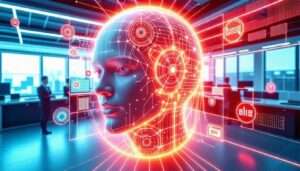Are you curious about how machines are able to process and analyze huge amounts of data that would take humans ages to process? The answer lies in Deep Learning. This cutting-edge technology, based on Artificial Intelligence, is transforming the world we live in. Deep Learning, also known as Neural Networks, is making strides in various fields, from speech recognition to image recognition, and predictive analytics to natural language processing. The use of Deep Learning models is providing more accurate results than previously possible and enabling efficient data analysis. The benefit of this is that it is revolutionizing the way Artificial Intelligence is used in Machine Learning. In this blog post, we will explore the world of Deep Learning and how it is revolutionizing data analysis. We will delve into the benefits of Deep Learning, including precise speech recognition, accurate predictive analytics, and improved data analytics. The potential for Deep Learning is limitless, and it is changing lives for the better. As we continue to see breakthroughs in this field, it is clear that Deep Learning is here to stay, and it will likely continue to transform the way we interact with the world.
As a data analyst, I have found that using deep learning and machine learning has completely transformed the way we analyze data. The algorithms are capable of identifying patterns and making predictions that humans can't even begin to comprehend.
One of the benefits of this technology is that it enables us to efficiently analyze large amounts of complex data. The algorithms can quickly process data, find patterns and correlations, and provide insights that would take months or even years for a human to find. It's like having a team of experts at your fingertips, working 24/7.
This level of efficiency allows for better predictive analytics. By analyzing historical data and identifying patterns, deep learning algorithms can predict future outcomes with startling accuracy. For example, in the financial industry, algorithms can use past market data to predict future trends, helping investors make better informed decisions.
Another benefit of deep learning and machine learning is that it allows for customization. By continually learning from data, the algorithms can adapt and improve. This means that the insights gained from one dataset can be applied to another, improving the overall accuracy of predictive analytics.
deep learning and machine learning are powerful tools that can transform the way we analyze and predict data. The benefits of efficiency, accuracy, and customization make them indispensable for businesses and organizations that rely on data for decision making.
Networks are revolutionizing the way Artificial Intelligence is used in Machine Learning.
With the advent of networks, the potential for Artificial Intelligence (AI) to revolutionize the world of Machine Learning (ML) has never been greater. Networks allow for the seamless sharing and analysis of data by AI systems, which enables better decision-making and faster problem-solving.
One of the most significant benefits of networks in AI is their ability to connect disparate systems and data sources. This interconnectedness allows AI to access a wide range of data and to analyze it in a way that is not possible with traditional systems. This means that AI can identify patterns and trends that may not be visible to humans and use this data to make predictions or decisions in real-time.
Additionally, networks provide a platform for collaboration and knowledge-sharing between AI systems. Through this collaboration, machine learning algorithms can learn from each other and improve their accuracy and effectiveness over time. This means that AI systems can continue to learn and grow in their understanding of complex data and problems, leading to even more sophisticated and intelligent decision-making.
Overall, the benefits of networks in AI and ML are vast, from increased speed and accuracy to more sophisticated decision-making and data analysis. As the technology continues to evolve and improve, we can expect to see even greater advancements in the capabilities of AI, leading to a world that is smarter, more efficient, and more connected than ever before.
Data is being used to train Deep Learning models, providing more accurate results.
Deep learning models have been revolutionizing the world of artificial intelligence in recent years, and the driving force behind this improvement is data. Data is being used to train deep learning models, enabling more accurate and reliable results. The benefits of this advancement in AI technology are enormous and can be seen across various industries, from healthcare to finance and beyond.
One major advantage of using data to train deep learning models is that it enables these models to learn from vast amounts of data, allowing them to make predictions with greater accuracy. Data-driven models can recognize patterns in the data that are not apparent to humans, which allows them to make predictions based on these patterns.
Another major advantage of using data to train deep learning models is that it allows for more efficient and cost-effective decision-making. By analyzing large amounts of data, deep learning models can provide insights that would take humans months or even years to analyze. This means that companies can make faster and more informed decisions, which can lead to improved business outcomes and faster growth.
the benefits of using data to train deep learning models are numerous and varied. This technology has the potential to transform industries and change the way we do business. With more accurate predictions, more efficient decision-making, and other benefits, it’s clear that deep learning models are set to revolutionize the way we use data in the future.
Speech recognition are becoming more precise with the help of Deep Learning.
Recognition technology has come a long way in recent years. With the help of deep learning, speech recognition has become more precise than ever before. This is great news for businesses and individuals alike. Not only does it make it easier to interact with technology, but it can also improve productivity and accessibility.
One of the benefits of deep learning in recognition technology is its ability to learn from large datasets. This means that it can recognize patterns and nuances in speech that were previously difficult or impossible to detect. As a result, speech recognition systems are becoming more accurate and reliable. This can be particularly beneficial for individuals who have disabilities that make it difficult to use traditional input methods, such as keyboards or touchscreens.
In addition, recognition technology can help businesses automate certain tasks and make them more efficient. For example, speech recognition can be used to transcribe voice notes or dictations, saving time and improving accuracy. It can also be used to recognize and respond to customer inquiries, reducing the need for human intervention.
Overall, the benefits of recognition technology are clear. Thanks to deep learning, speech recognition is becoming more precise and reliable than ever before. As the technology continues to evolve, we can expect to see even more innovative uses for recognition technology in the future.
Analytics is being improved by Deep Learning, allowing for more accurate predictions.
Deep Learning is a powerful technology that allows computers to learn and make predictions in ways that were previously impossible. By processing large datasets through complex neural networks, Deep Learning algorithms can identify patterns and make predictions about future events with a high degree of accuracy.
One of the key benefits of Deep Learning is its ability to improve analytics. Traditional data analysis techniques often rely on static models that are incapable of adapting to new data or evolving trends. Deep Learning algorithms, on the other hand, are able to analyze vast amounts of data in real time, making it possible to detect subtle changes in patterns and make accurate predictions about future events.
The impact of Deep Learning on analytics is particularly significant in the world of business, where accurate predictions can make a huge difference to the bottom line. By using Deep Learning algorithms to analyze customer behavior, companies can identify trends and patterns that would be impossible to spot using traditional techniques. This can help businesses to make more informed decisions about which products to develop, which markets to enter, and which pricing strategies to adopt.
Overall, the benefits of Deep Learning are clear. By improving analytics and making more accurate predictions, this technology has the potential to revolutionize the way we do business and solve many of the world's most complex problems. Whether you're working in finance, healthcare, or any other industry, understanding Deep Learning is essential if you want to stay ahead of the curve.
Conclusion
Deep learning has proven to be a powerful tool that provides remarkable benefits in data analysis. By enabling efficient data analysis and better predictive analytics, it is revolutionizing the way Artificial Intelligence is used in Machine Learning. The use of data to train Deep Learning models provides more accurate results and is transforming several sectors, including healthcare, finance, and transportation, among others. As a reader, it is essential to understand the significance of Deep Learning and its relevance to our daily lives. By embracing technological advancements and leveraging the power of Deep Learning, we can unlock new opportunities and drive innovation in various industries.
FAQ
Q: What is deep learning?
A: Deep learning is a subset of machine learning, which involves training artificial neural networks to recognize complex patterns in data. Neural networks consist of interconnected nodes or neurons, which are organized in layers and can learn to perform specific tasks by adjusting the strength and importance of their connections based on feedback from the data. Deep learning is particularly useful for tasks such as image and speech recognition, natural language processing, and autonomous decision-making.
Q: How is deep learning different from traditional machine learning?
A: Traditional machine learning algorithms rely on feature engineering, which involves manually selecting and extracting relevant features from raw data, and then using statistical or mathematical techniques to learn from these representations. Deep learning, on the other hand, can learn high-level abstract representations of data directly from raw inputs, without the need for explicit feature engineering. This allows neural networks to handle a wider range of data types and to achieve higher accuracy and performance on complex tasks.
Q: Is deep learning only applicable to large datasets?
A: While deep learning models typically require large amounts of data to train effectively, they can also be adapted to smaller datasets by using techniques such as transfer learning, which involves reusing pre-trained models for similar tasks. Additionally, some types of neural networks such as convolutional neural networks (CNNs) are designed specifically for analyzing image and video data, which tend to be larger and more complex than other types of data.
Q: Can deep learning models be easily interpreted and explained?
A: One challenge of deep learning is that the internal workings of neural networks can be difficult to interpret and explain, especially for complex models with many layers and parameters. However, recent research has focused on developing techniques for visualizing and explaining the behavior of neural networks, such as activation heatmaps, saliency maps, and gradient-based attribution methods. Additionally, there is ongoing research on developing more interpretable architectures and training methods, such as decision trees and symbolically guided learning.
Q: Is deep learning only useful for academic research or specialized applications?
A: Deep learning has already been successfully applied to a wide range of practical applications, including image and speech recognition, natural language processing, autonomous driving, robotics, and healthcare. Many companies are investing heavily in developing deep learning technologies, and there is a growing demand for skilled data scientists and AI engineers with deep learning expertise. According to a recent report from Grandview Research, the global deep learning market is expected to reach $10.2 billion by 2025.




